Petsamo- Kirkenes Operation Background
The Petsamo-Kirkenes operation was an offensive operation by the Soviet troops of the Karelian Front, Northern Fleet and Norway Resistance Fighters, carried out against the German group in the Petsamo and Finnmark province in northern Norway from October 7 to November 1, 1944, during World War II.
The task of the Soviet troops was to liberate the villages of Luostari and Petsamo with the aim of destroying the main forces of the 19th Wehrmacht Mountain Corps, fortified in the Petsamo area, and further advance on Kirkenes in Northern Norway.
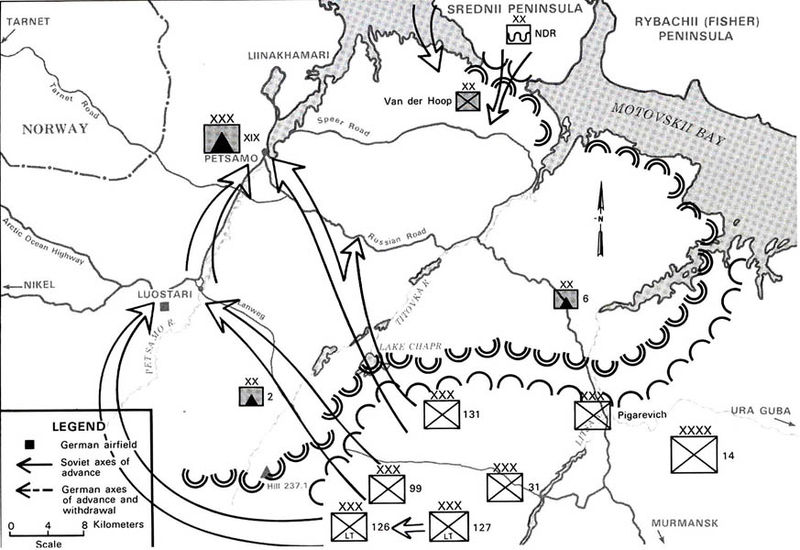
A map of the Operation
Situation on the eve of the battle
By the end of the summer of 1944, all of Norway and part of Finland were occupied by German troops, and collaborationist governments operated on the territory of these states. In Norway alone, in 1944, at least 11 German divisions were deployed, some of which were formed or replenished at the expense of the local population.
From 22 to 29 August 1944 the Royal Navy was held naval operation «the Goodwood», with the goal to destroy the German battleship Tirpitz and the port infrastructure of the Kriegsmarine naval base in Kofjord in northern Norway. From the beginning of 1942, Tirpitz posed a significant threat to Allied convoys carrying cargo across the Norwegian Sea to the Soviet Union. The German battleship was able to suppress the close escort forces intended for Arctic convoys and cruises in the North Atlantic. However, it was not possible to sink the battleship then.
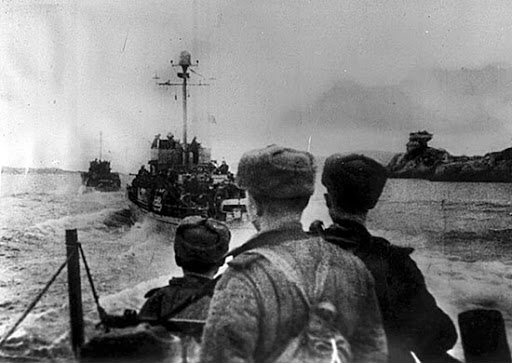
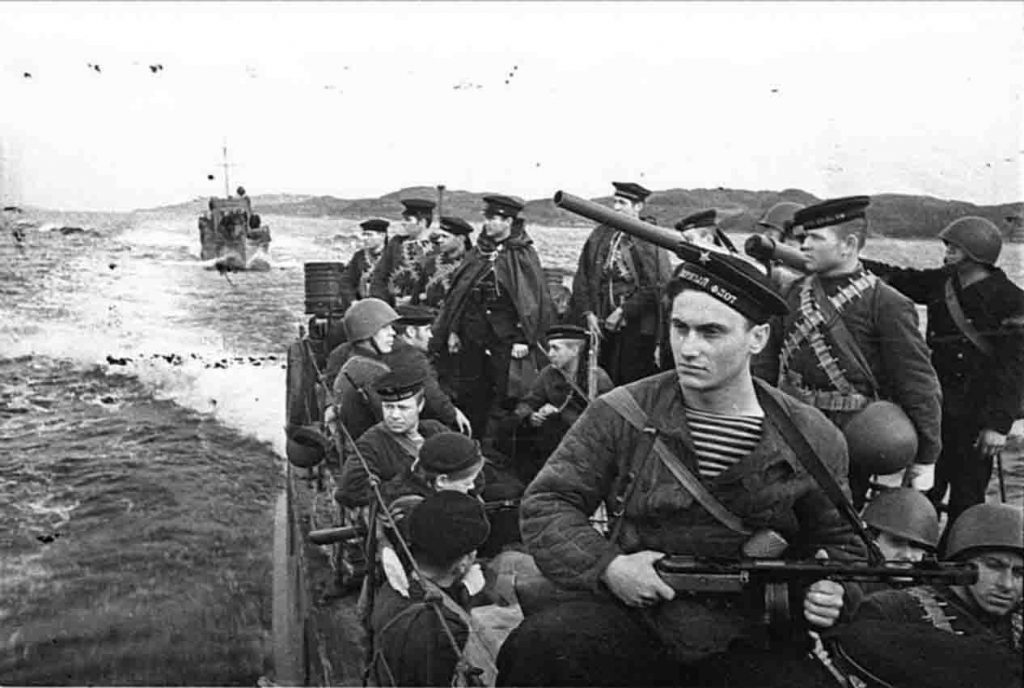
In the summer of 1944, the Red Army on the Karelian Front successfully carried out the Vyborg-Petrozavodsk strategic offensive operation , which led to Finland’s withdrawal from the war. As a result, the command of the German 20th Mountain Army was forced to withdraw its troops from Finnish territories. The Finns also began to withdraw all their troops from the front line.
As of October 1, 1944, the Germans held a part of the Soviet land west of Murmansk in the Arctic Circle. The front line ran from the Malaya Volokovaya Bay along the isthmus of the Sredny Peninsula , further from the Bolshaya Zapadnaya Litsa Bay to the Chapr and Koshka-Yavr lakes. Here the Germans created a powerful defense, consisting of three lines, with long-term defensive structures – the so-called “granite” (Lappish) defensive rampart. The depth of the defense was up to 150 kilometers, and its length was up to 100.
Machine-gun nests and separate positions for artillery were carved into the rocks, making them practically invulnerable to heavy shells and large aerial bombs. By the beginning of October 1944, there were 15-20 long-term structures per 1 kilometer of the enemy’s defense front. The garrisons of the strong points had large supplies of food, water and ammunition and could fight in complete encirclement for a long time. Long-term structures consisted of reinforced concrete and armored firing points, minefields and anti-tank ditches. The impassable mountainous, wooded, swampy terrain and the complete absence of roads seriously impeded the conduct of any maneuver of troops, and all enemy strongholds were adapted for circular defense.
Relying on the powerful Lapland defensive rampart, the German command hoped to hold onto the northern regions of Finland and Norway. The main tasks were considered: the defense of the metallurgical plant in Kolosjoki , maintaining access to the deposits of copper, nickel and molybdenum and to strategically important ice-free ports, on which the large forces of the Kriegsmarine were based and from which the raw materials necessary for the German military industry were supplied to Germany.
Defense tasks were assigned to the 19th Mountain Corps of the Wehrmacht. As a part of which at the end of September 1944 there were 3 mountain divisions and 4 brigades, numbering 53 thousand people, over 770 guns and mortars. From the air, they were supported by the aviation of the 5th Luftwaffe Air Division in Norway (160 aircraft) and significant naval forces based in the ports of Northern Norway (1 battleship, 12-14 destroyers, up to 30 submarines and other ships, up to 20 ships in total and courts).
Also, parts of the 19th Mountain Corps were covered by coastal and anti-aircraft artillery, anti-submarine minefields were placed along the coast , approaches to bases and ports were covered by patrol boats. In the depths of the defense, strong points were built: Luostari , Petsamo and Kirkenes , which were also supply bases.
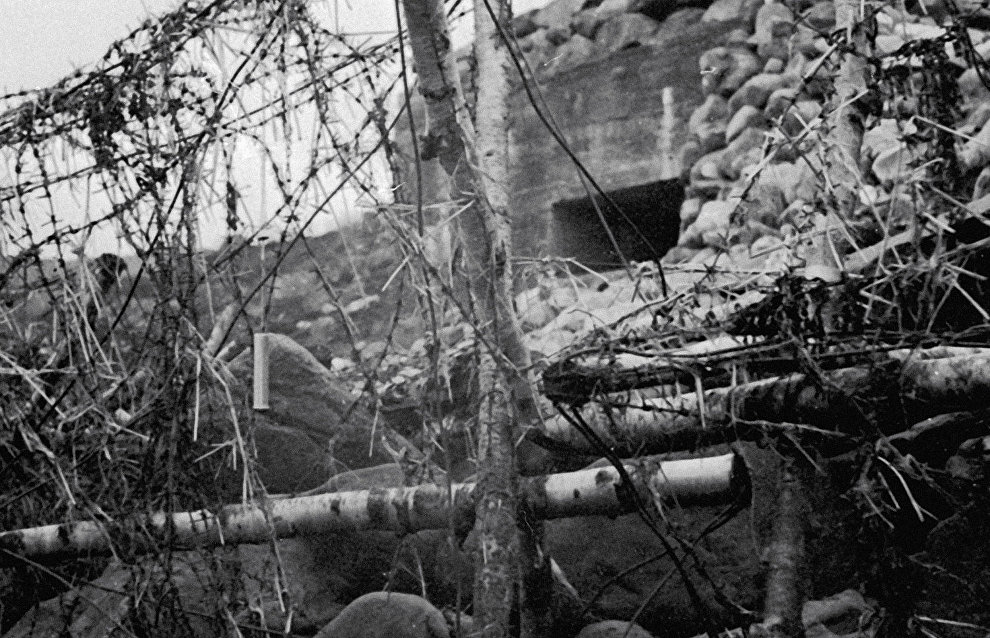
German defences and fortification bunkers
In September 1944, the troops of the 19th (Lieutenant General G.K. Kozlov ) and 26th (Lieutenant General L.S.Skvirsky ) armies went on the offensive on the Kandalaksha and Ukhta directions. On September 14, the village of Alakurtti and a strategically important airfield were liberated , to which the 415th IAP from the 7th Air Army was transferred , which took an active part in the Petsamo-Kirkenes operation. In the last days of September, units of the 19th Army reached the state border with Finland, liberating 45 settlements and incapacitating about 7 thousand German soldiers and officers.
The 26th Army, which was opposed by the 18th Mountain Rifle Corps (General of the Infantry F. Hochbaum ), by the end of September had advanced 35 km into the interior of Finland.
During the September offensive of the troops of the 19th and 26th armies, Soviet Karelia was completely cleared of enemy troops. The strategic position in the northern sector of the Soviet-German front has significantly improved, all conditions have been created for the complete liberation of the Arctic from the Nazi occupiers.
Photographs from those years show that the Norwegians greeted the Soviet troops as liberators with flowers and greetings. The offensive operation instilled in the population hope for liberation, and added courage to provide all possible assistance to the Soviet troops.
After the official statement of the President of Finland Gustav Mannerheim about the complete breakdown of relations with Germany on September 2, 1944, on September 3, the German command began to implement ‘Operation Birke’ on the withdrawal of its troops from the northern regions of Finland and the organization of a powerful defense of the Kolosjoki nickel mining area. Part of the withdrawn forces from the 36th Mountain Corps were subsequently concentrated in the Petsamo area.
Conventionally, the operation can be divided into three stages – the breakthrough of the German fortified positions on the “granite rampart” and the capture of Petsamo, the capture of the nickel production areas of Kolosjoki, the entry into the territory of Norway and the liberation of the cities of Kirkenes and Nautsi. During the operation, Soviet troops undertook several amphibious assault forces by the forces of two marine brigades of the Northern Fleet and assault units of the 14th Army of the Karelian Front, during which they were for the first time beyond the Arctic Circle. American-made Ford GPA amphibious engineering and reconnaissance vehicles supplied by the allies to the Soviet Union under Lend-Lease were successfully used in combat conditions.
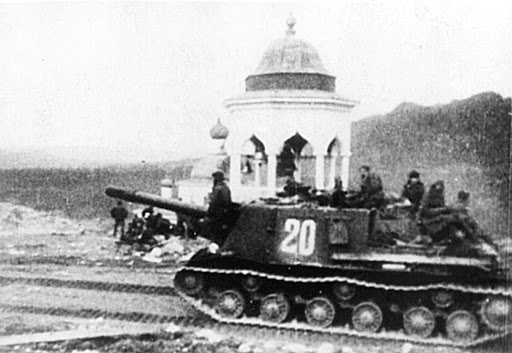
ISU-152’s that were used during the operation.
During preparations for the operation, the Stavka and the front command concentrated a large number of artillery pieces and mortars , including those of large caliber, in the direction of the main attack. A few days before the start of the offensive, tank units and regiments of self-propelled guns SU-152 and ISU-152 were brought up. South of Lake Chapr in the direction of Luostari – Kolttakyla, where the main forces of the 99th and 131st rifle corps attacked, among other things, the newest Andryusha rocket launchers for that time on the Studebaker US6 self-propelled chassis were deployed with M-31 projectiles (310 mm), which differed in greater power and efficiency from the well – known M-13.
On the morning of October 7, 1944, artillery preparation began , which lasted two hours and thirty-five minutes. Basically, it was possible to suppress artillery and mortar batteries, and other enemy fire weapons in the strongholds of the first line. In the last minutes of artillery preparation, rifle units, supported by tanks and self-propelled guns, went on the attack, breaking into the trenches and fortifications of the first line. Such offensive tactics were more than justified when capturing enemy fortified areas on stone heights and open areas of the polar tundra or the rare undersized taiga.
In the direction of the main attack, bloody battles broke out for strong points on the Bolshoi and Maly Karikvaivish mountains. I had to advance on icy stone hills and rocks. The fortification on Mount Maly Karikvaivish was captured by soldiers of the 131st rifle corps by 15:00. By the end of the first day of fighting, the entire garrison of the strongpoint was destroyed. By the end of the first day, rifle and tank units operating on the right flank of the strike force broke through the German’s main defensive zone, crossed Titovka on the move and reached the borders of lakes Kuosme-Järvi and Loy-Yarv, capturing important strongholds on the second zone of the enemy defense.
The enemy stubbornly resisting, repeatedly launched counterattacks. To smoke the enemy out of crevices and “fox holes”, it was necessary to use smoke bombs. Granite structures, from which it was impossible to knock out the Nazis by any means, were undermined by special directional charges. For the successful fulfillment of the assigned tasks, the rifle units were reinforced with KV-1 and T-34 tanks. In the Far North, this was the first case of large-scale combat use of tanks in offensive operations. The German command considered the use of tank forces in this area almost impossible and ineffective.
Sharply rugged terrain, steep climbs and stone deposits made it difficult for troops, especially artillery, tanks and self-propelled guns to move – there were no roads here. Heavy equipment had to be dragged by hand or with the help of deer and horses. Ammunition and everything else were delivered in the same way. But despite the difficulties and fierce resistance of the enemy, the Soviet units continued to move forward and by October 11 they reached the Titovka River along the entire front.
The 181st Special Reconnaissance Detachment of the Northern Fleet carried out an operation to capture the port of Liinakhamari. The fortified German port was covered by the Krestovy and Romanov capes. In the granite base of the Krestovy Cape, the Germans equipped various fortifications, dugouts, firing points, bunkers and trenches. At Cape Romanov, concrete bunkers are still preserved, where German torpedo tubes were located. From these bunkers, the entrance to the bay was clearly visible, which made it possible to torpedo any ship or submarine.
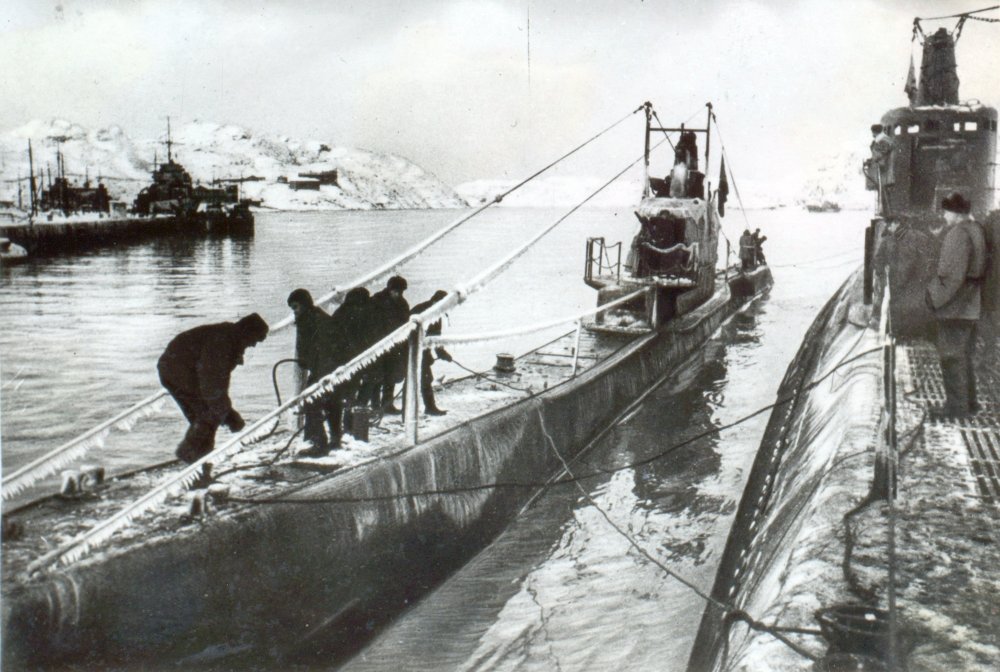
Several of the Soviet Submarines that participated in the Operation
On October 12, 1944, a naval sabotage detachment under the command of Major I.P.Barchenko-Emelyanov and Lieutenant V.N.Leonov attacked two German batteries at Cape Krestovoy and, after a fleeting battle, captured them with minimal losses. The capture of the batteries ensured the successful landing of the amphibious assault in Liinakhamari , the occupation of this area and the capture of the city of Petsamo on the night of October 15.
In total, as a result of the battles from October 7 to 11, 1944, the strike forces of the 14th Army broke through the enemy’s defenses in a strip up to 20 kilometers wide to a depth of 16 kilometers, causing significant damage to the German 2nd Mountain Division from the 19 Mountain Corps. The enemy lost over 2,000 people killed. 210 soldiers and officers were taken prisoner, 34 guns, 8 mortars, 19 machine guns, 12 radio stations, 90 horses, 9 warehouses with various property were captured.
Entry into Norway and liberation of Kirkenes
On October 22, the 131st corps entered the battle for the Norwegian city of Tarnet. At the same time, the marines, with artillery support from the fleet, were clearing the coast. The ships of the Northern Fleet landed three more tactical assault forces on the southern coast of the Varanger Fjord : October 23 – in Kobholmfjord, October 25 – in Holmengrofjord. All three landings were successful and played a positive role in the Soviet offensive.
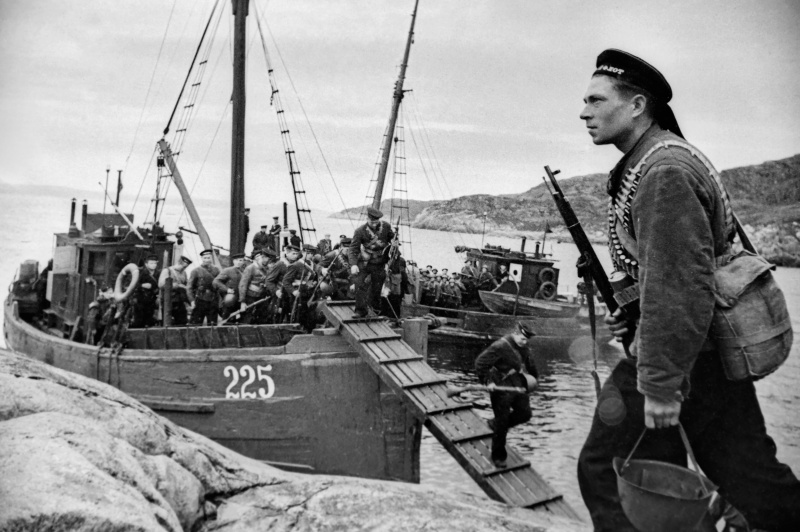
Withdrawing to Kirkenes, the enemy used various obstacles on an ever larger scale and caused all kinds of destruction on the roads. The road to Kirkenes was mined and the suspension bridge over the fjord was blown up. The Yarfjord was crossed by amphibians and fishing boats. Norwegian patriots, who went to sea on two motorboats, rendered great help to the fighters. They rescued the crews of knocked out amphibians and, despite the shelling, ferried them to the other side. When then, when crossing the Elvenes Fjord, it was necessary to start all over again and the 14th division directed the landing on rafts, the local residents again supported the Soviet army. The same was done in the Backfjord.
On the morning of October 25, 1944, the 14th and 45th Infantry Divisions of the 131st Infantry Corps crossed the Beckfjord and, in cooperation with the 10th Guards and 65th Infantry Divisions of the 99th Infantry Corps , captured the city and port of Kirkenes. The day before, at midnight on October 24, the last two mountain-ranger companies of the Wehrmacht left the city. Only a sapper platoon remained in the city with the task of destroying buildings, warehouses and port facilities. Most of the German garrison and the retreating remnants of the 19th Mountain Corps withdrew to the north of Norway through the Neiden, the rest were evacuated by sea – according to Soviet intelligence, the last ships of the caravan, covered by warships, left Kirkenes at noon on October 24.
Completion of the operation
On the night of October 26, units of the 99th Rifle Corps crossed the Langfjord and captured the Norwegian settlements of Khebugten, Lenkoselven, Buholm, Stonga, Veines.
On October 26, the evacuation of German troops from the Varanger Peninsula began. On the same day, together with units of the 63rd Marine Brigade and 126th Lsk, the village of Munkelven (Munkefjord) was liberated.
On October 29 , when the weather improved somewhat, Soviet torpedo and attack aircraft flew in three rounds to bombard ships in Tanafjord. During the raids, they managed to seriously damage at least three enemy ships. Separate assault team flew to bomb concentrations of troops in Vardo. Torpedo boats from Rybachy also tried to intercept the convoys, but due to strong excitement they were forced to return to base.
A reconnaissance detachment sent forward pursued the enemy over the next three days to Ivalo (The last rearguard of the German troops left Ivalo on November 3), where Soviet troops on November 5 came into contact with Finnish troops approaching from the south and suspended further pursuit.
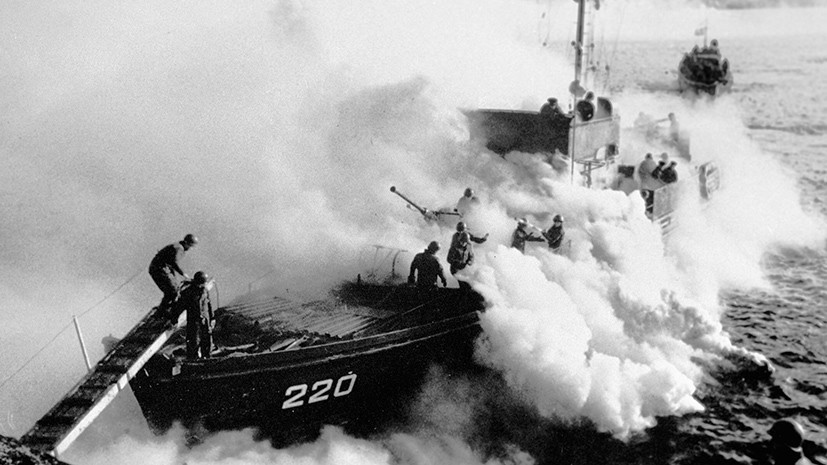
Soviet Ship using Smoke to mask their Approach.
November 6 took place the last battles between the German and Soviet troops on Norwegian territory in Varangerbotn. November 7 after the explosion of the bridge over the River Tana German troops left the Tana bru. November 8 , Soviet troops reached the Ruostefelbma and stopped his progress there. On November 8, 1944, after a deep pursuit of the retreating enemy forces in the western and southern directions, the Petsamo-Kirkenes offensive operation was finally completed in all sectors of the army.
On January 9, 1945, reconnaissance entered Lakselv (Lakselv can be reached both from Tana-bru and from Ivalo along straight roads), which became the last settlement in the advance of the Red Army in the Norwegian Arctic.
Outcomes and losses of the parties
The Petsamo-Kirkenes offensive operation, is known primarily as an operation of strategic importance , successfully carried out by fighters of the 14th Army of the Karelian Front and sailors of the Northern Fleet in the Arctic , at the junction of the borders of three states – the Soviet Union , Norway and Finland from October 7 to November 1, 1944.
In the course of the offensive, the increased military skill of the Soviet command was manifested in the organization of operational-tactical interaction of the ground forces with the forces of the fleet. The troops resorted to flexible maneuvering with specially created light and mobile rifle corps. Engineer units and signal troops showed high efficiency. The retreating units of the 20th Mountain Army and the Kriegsmarine lost a large amount of military equipment, ammunition and weapons, fodder and food.
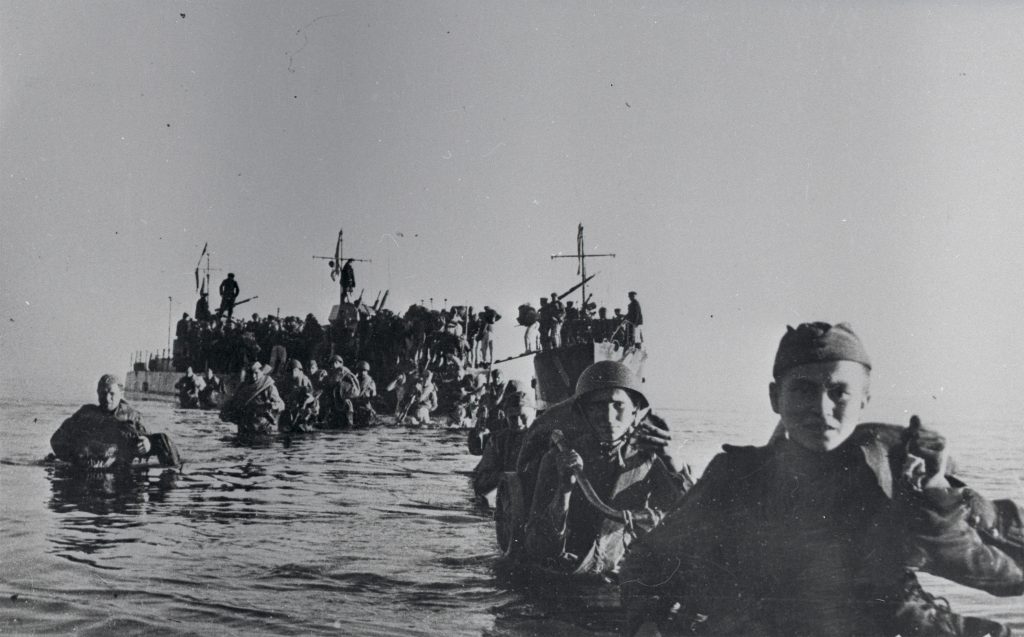
Soviet Troops Disembarking During The Operations
The operation was of great military and political importance. The Germans lost their foothold, from where they threatened the northern regions of the Soviet Arctic since 1941. The original Russian land of Pechenga was returned. The eastern regions of the Norwegian province of Finnmark were liberated from the German occupiers , which gave an additional impetus to the development of the national liberation movement in Northern Norway in the fight against the invaders and collaborators.
The victory of the Red Army in the North had a significant impact on the policy of the ruling circles of Finland and the Scandinavian countries, forcing the invaders to move to the complete evacuation of their units and formations from the territory of Finland and Northern Norway.
Participation of the Norwegian armed forces in the liberation of Finnmark province
he successful conduct of the Petsamo-Kirkenes operation by Soviet troops in October 1944 and the entry of the Red Army into the kingdom contributed to the development of the national liberation movement and the participation of Norwegian military units formed by the government in exile in operations for the complete liberation of Northern Norway.
In October 1944, the government of Norway in exile and the Stavka drew up a plan for an operation to transfer to the Petsamo – Kirkenes area , “Norwegian police forces” Russian. and mountain rifle units to participate in the fight against the retreating units of the 20th German mountain army and the establishment of state order in the liberated territories.
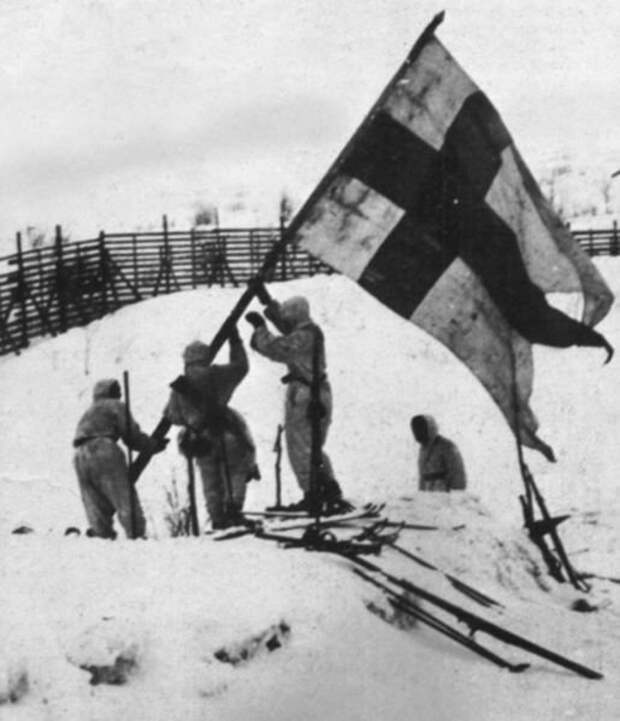
Norway Armed Forces raising their Flag upon a portion of the battlefield.
November 8 1944 the year in the area of Kirkenes from Murmansk arrived the Norwegian military mission led by Colonel AD Dahlem (English) Russian. consisting of 48 people. At the same time , a mountain rifle company of 234 people was transferred from Scotland , and a little later two police companies of 307 people. At the beginning of January 1945, the total strength of the Norwegian armed forces was already 1,350 people, which became the backbone of the creation of the new Norwegian army. By May 1945, their number had increased to 2,735. Also, since December 1944, a detachment of light forces of the Norwegian fleet was based on Kirkenes: the corvette “Eglangins”, 3 minesweepers, 16 auxiliary ships and boats.
The military mission and the arrived Norwegian troops were enrolled in the 14th Army for all types of allowance, they were given: 685 automatic rifles, 40 light machine guns, ammunition for them, cars, fuel, animal-drawn vehicles , medical equipment and much more. The total expenses of the Soviet Union for the maintenance of the Norwegian troops alone in 1944-1945 amounted to more than 27.5 million rubles.
On the liberated territory, units were formed from local volunteers. With the support of Soviet aviation, ships of the Northern Fleet and allies, by May 1945, they cleared the entire territory of northwestern Finnmark, the provinces of Nordland and Troms of the remaining German troops and police forces of collaborators.
Participation of the Northern Fleet in the operation
The operation is distinguished by close interaction of the troops advancing along the coast with the forces of the Northern Fleet. The ships and aircraft of the fleet supported the troops advancing along the coast with artillery fire and bomb strikes. During the operation, the fleet landed about 10 amphibious assault forces, which played a role in ensuring the high pace of the offensive.
The forces of the fleet attacked enemy ships with the aim of disrupting the delivery of reinforcements and the evacuation of its troops. The submarines of the Northern Fleet in this operation sank 15 ships and warships without losses on their side.
In total, 156 German ships and vessels were sunk in this operation by the forces of the fleet (according to Soviet data). Torpedo boats sunk 4 transports, 4 patrol ships, 4 minesweepers and 1 motorboat at the cost of losing 1 torpedo boat.
On the territory of the Murmansk Region and the Kola Peninsula , monuments and monuments have been erected that perpetuate the feat of Soviet soldiers during the Great Patriotic War.
The most famous is the Valley of Glory on the right bank of the Western Litsa River – the place of heroic deeds of the Red Army and Red Navy men in 1941-1944. Here, in the course of fierce battles, more than 7,000 thousand people died and the offensive of German troops, rushing to Murmansk, was stopped.
Many monuments are located in the Pechenga district of the Murmansk region. At the entrance to the village of Pechenga , on the E105 highway, a T-34 tank was erected on a pedestal. In 1991, a memorial was opened nearby to the Austrian mountain riflemen from the 19th Wehrmacht Mountain Corps, who died in 1944.
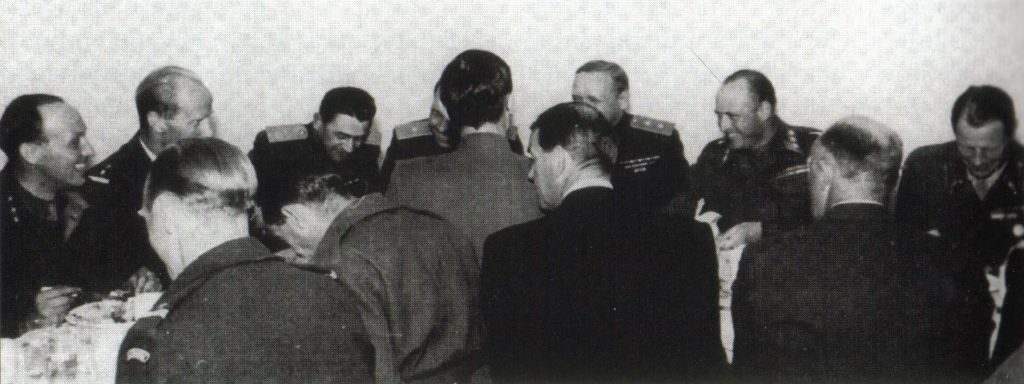
Officials From Norway and Soviet Officers having a celebratory dinner upon the end of the operations
In the hero city of Murmansk, a majestic memorial has been erected to all the defenders of the Arctic during the war years. This is a 35-meter-high figure of a Soviet soldier who received the name “Alyosha” from the residents of the city. A monument to the marines of the Northern Fleet has been erected in the city of Severomorsk.
The scouts who died in the capture of the port of Liinakhamari were buried at the highest point of Cape Krestovy. The mass grave contains the remains of 20 people. At the foot of the monument, which is visible from afar, there is a plaque on which all the victims are listed by name.
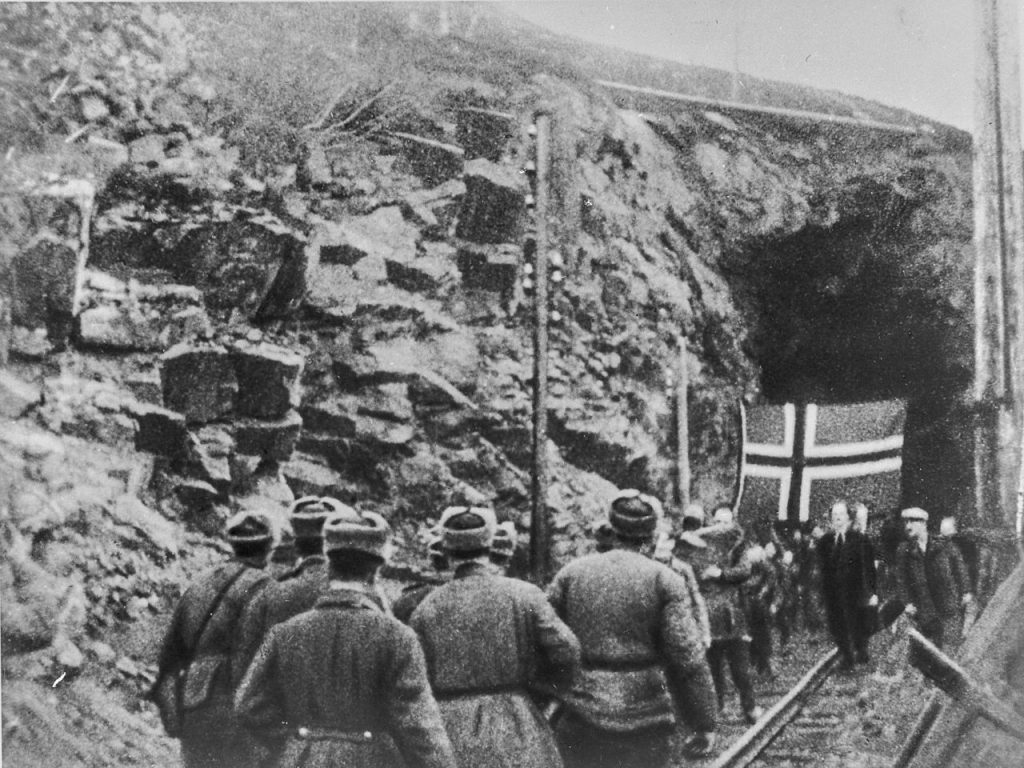
Norway Resistance Fighters Emerging out of Caves to Meet Soviet Troops.
In Kirkenes, there is a monument to the liberators – the figure of a Soviet soldier with a PPSh-41 in his hands. This stone statue was created by the Norwegian sculptor S. Fredriksen. There is an inscription on the monument: “To the brave Soviet soldiers in memory of the liberation of the city of Kirkenes in 1944”.













